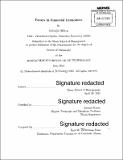Essays in financial economics
Author(s)
Mitra, Indrajit
DownloadFull printable version (11.43Mb)
Other Contributors
Sloan School of Management.
Advisor
Leonid Kogan.
Terms of use
Metadata
Show full item recordAbstract
This dissertation consist of three essays. In the first essay, I examine optimal dynamic contracting between risk-averse investors and firm insiders in a dynamic general-equilibrium model with heterogeneous firms. The equilibrium optimal contract features a higher rate of inefficient liquidations in aggregate states with low productivity and a reward-for-luck policy in high productivity states. I show that with realistic parameters, moral hazard has a first order quantitative effect on equilibrium dynamics of macro-economic quantities and asset prices. The conditional dynamics depend on the time-varying cross-sectional distribution of financial slack of firms in the economy. Moral hazard improves upon the predictions of the friction-less economy in three ways. First, the sensitivity of risk premia and key macro-economic quantities rises after successive negative aggregate shocks. Accumulation of small shocks results in a disproportionately large decline in aggregate quantities, and a rise in risk-premia. Second, inefficiencies resulting from second-best contractual arrangements amplify the effect of primitive shocks and make the economy more sensitive to negative than to positive shocks. Third, controlling for current aggregate productivity, firm exit rates contain incremental information about future output growth. In the second essay I quantitatively analyze the cross-sectional implications of optimal dynamic contracting between risk-averse investors and firm insiders in a dynamic general equilibrium model. I make two changes compared to essay one. First, I allow for firm-level investment. Second, I model firms to use a decreasing returns to scale technology instead of a linear one. My model makes two predictions on steady-state capital accumulation which are consistent with empirical evidence. First, I show that conditional on survival, younger firms are smaller and have higher expected growth rates. Second, investment rates in small firms are more volatile and more sensitive to realized cash flows than large firms. In the presence of aggregate shocks, my model predicts that the conditional aggregate dynamics of key macro-economic quantities depends on the cross-sectional distribution of firm-level investment rates. Controlling for aggregate productivity, states of the economy in which a higher fraction of firms have lower investment rates are characterized by low aggregate output, investment, and consumption, and higher risk-premium. I provide quantitative estimates in a calibrated model. In the third essay, we propose a simulation-based procedure for evaluating approximation accuracy of numerical solutions of general equilibrium models with heterogeneous agents. We measure the approximation accuracy by the magnitude of the loss suffered by the agents as a result of following sub-optimal policies. Our procedure allows agents to have knowledge of the future paths of the economy under suitably imposed costs of such foresight. This method is very general, straightforward to implement, and can be used in conjunction with various solution algorithms. We illustrate our method in the context of the incomplete-markets model of Krusell and Smith, where we apply it to two widely used approximation techniques: crosssectional moment truncation and history truncation.
Description
Thesis: Ph. D., Massachusetts Institute of Technology, Sloan School of Management, 2015. Cataloged from PDF version of thesis. Includes bibliographical references.
Date issued
2015Department
Sloan School of ManagementPublisher
Massachusetts Institute of Technology
Keywords
Sloan School of Management.